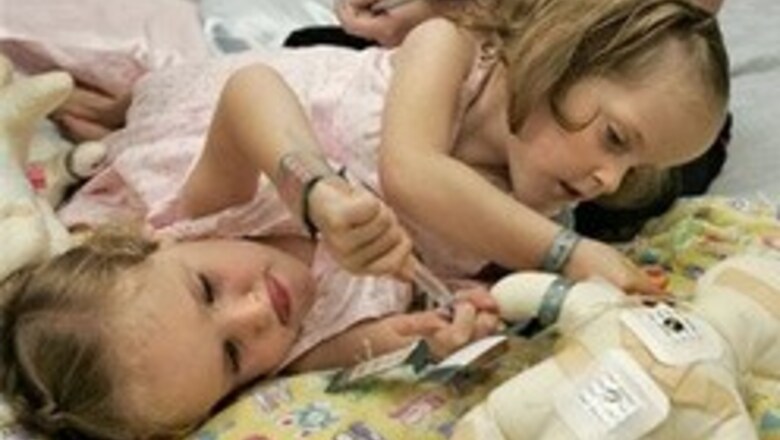
views
Salt Lake City: They were born in a perpetual hug, their little bodies fused at the midsection so that they are practically face-to-face, and have grown into outgoing 4-year-olds who chatter away and finish each other's sentences.
Kendra and Maliyah Herrin say they like being together all the time, but they are also full of plans for separate lives.
They want to walk without using their wheeled walker, sleep in bunk beds and ride bikes.
On Monday, surgeons at Primary Children's Medical Center will try to separate the twins in an operation that could take 14 to 30 hours.
The sandy-haired, blue-eyed girls share one pair of legs, a liver, one functioning kidney, and part of the large intestine.
If all goes according to plan, each girl will get one leg and Kendra the kidney. Maliyah will be put on dialysis until she is strong enough for a kidney transplant from her mother, Erin Herrin, ideally within three to six months.
Dr Rebecka Meyers, the hospital's chief of pediatric surgery, said she believes this will be the first time separation surgery has been attempted on twins with a shared kidney.
Conjoined twins occur about once in every 50,000 to 100,000 births. Only about 20 per cent survive to become viable candidates for separation, and most separation surgeries occur when the twins are 6 to 12 months old.
"The reason for that is partly psychological, partly mechanical," Meyers said. "If Maliyah had had a kidney, these girls would have been separated a long time ago," she added.
A kidney transplant would have been harder before age 4, and doctors advised waiting.
Before deciding to go ahead, doctors and the girls' parents — who also have 6-year-old daughter and 14-month-old twin boys — talked with ethicists, because the surgery could make things worse for Maliyah, who faces the risky prospect of an organ transplant.
"We have more than one ethicist who thinks these girls don't need to be separated," Meyers said.
"Mom and Dad have had a chance to hear all of that and talk to people on both sides," she added.
Before making their decision earlier this year, the Herrins had Kendra and Maliyah talk with a psychologist.
The couple concluded that while the girls expressed some fear about the surgery, separate "was how they saw themselves when they were older," Jake Herrin said.
The twins are outgoing and greet a visitor with a cascade of curious questions — "What's your name?" "Do you like Barbie?" "Do you like my hair?"
To prepare them for surgery, doctors inserted 17 expanding balloons into the twins' torsos in June.
Filled with saline solution, the balloons stretch the skin and muscles, giving doctors more tissue to work with during plastic surgery after the separation. Each week more saline has been added to the balloons.
The process has been more painful than expected and the skin over a least one expander has been slow to heal, delaying surgery by a week.
To reduce the pressure on their tender skin, the girls sleep on a 3,000-pound oval hospital bed that is filled with sand.
To help them understand what is about to happen to them, Kendra and Maliyah have been given a set of conjoined stuffed dolls to play with.
Like the girls, the dolls get Band-Aids and shots. On July 20, Kendra performed separation surgery on the dolls, as Maliyah looked on.
"They gave the babies medicine and said that they were so brave," Erin Herrin wrote in a posting on the North Salt Lake family's website.
"It is incredible to us how much they really do understand," Erin added.



















Comments
0 comment